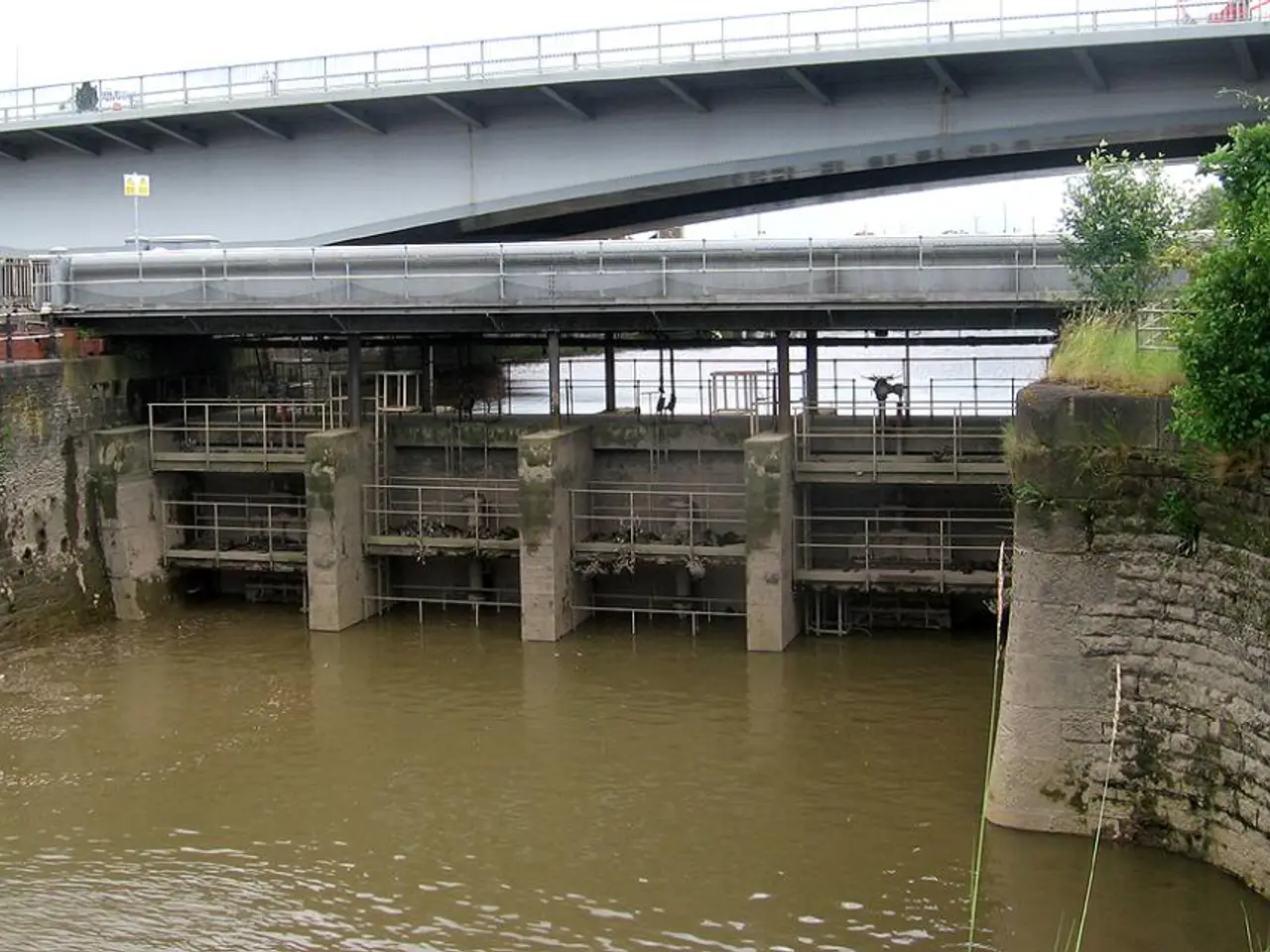India's Comprehensive Counteraction to China's Megadam Project in Mendog
In the heart of Tibet, China is constructing the Medog Mega Dam on the Yarlung Tsangpo River, a waterway that transforms into the Brahmaputra as it enters India. This colossal hydropower project, with an installed capacity of approximately 60 GW, is expected to generate about 300 billion kWh annually, making it the world's largest hydropower dam[1][2][5]. However, the dam's strategic, ecological, and federal implications for India are significant and complex.
Strategically, the dam signals China's ambitions in green energy leadership and regional development, but it also heightens geopolitical tensions with India. The project is being built without prior consultation with India, the lower riparian country, raising concerns about water security and sovereignty[2][5]. India's Ministry of External Affairs has condemned the plan, citing that it offers China an unfair strategic advantage by controlling the upstream flow of the Brahmaputra[5]. The site’s proximity to disputed border areas adds to the geopolitical sensitivity[3].
Ecologically, the dam’s construction involves diversions of the river and aims to build five cascade hydropower plants, possibly including reservoir-like structures despite claims it is run-of-the-river. Such interventions are likely to alter natural river flow, affecting aquatic ecosystems, fisheries, sediment transport, and regional biodiversity, particularly during lean seasons when glacier and snowmelt contributions are critical to downstream flows[2]. Experts warn that the dam could become a "ticking water bomb" with risks of impacting downstream water availability and environmental stability in India and Bangladesh[4][5].
From a federal perspective for India, the dam presents challenges including the need to safeguard water and food security for millions downstream, address ecological impacts, and engage diplomatically or legally with China to ensure sustainable and equitable water management. The lack of transparency from China and the absence of cooperative water-sharing mechanisms exacerbate these federal challenges[2][5].
In addition, data opacity prevents real-time flood forecasting beyond eight hours in the Siang reach, a critical issue for large-scale evacuation[6]. Sediment entrapment threatens the stability of Majuli-island and the agronomy of the Bengal delta[7]. An upstream power controlling physical flow, technical data, and financial capacity can shape trans-boundary bargaining to its advantage[8].
To mitigate these challenges, the Jogighopa-Tista link should be prioritised for canal links to divert excess Brahmaputra monsoon flows[9]. A Hydro-Science and Technology Operations Corps should be created for dam-break modelling[10]. A no-surprise clause with China should be negotiated and linked to existing meetings[11]. The revenue-sharing formula of Itaipú on the Paraná demonstrates how benefit-sharing can mitigate asymmetry[12].
Anti-dam movements in Upper Siang & Dibang reflect rights-vs-risk trade-offs, highlighting the need for balanced decision-making[13]. The Medog cascade is located within the Great Bend, 30 km upstream of Gelling in Arunachal Pradesh[14]. The dam carries about eight hundred million tonnes of sediment annually, building the Bengal delta and sustaining flood-plain fertility[15]. However, sediment starvation poses a compounded risk to both dam integrity and downstream livelihoods[16].
Reservoir induced seismicity, glacial-lake outburst floods, and sediment starvation pose further compounded risks to both dam integrity and downstream livelihoods[17]. The 1950 Assam-Tibet earthquake (moment magnitude 8.6) generated massive landslides and natural dam bursts, illustrating worst-case cascading failures[18].
In conclusion, the Medog Mega Dam is progressing towards becoming a colossal green-energy infrastructure but poses significant strategic, ecological, and federal challenges for India related to water rights, environmental sustainability, and geopolitical stability in the Brahmaputra basin[1][2][3][5]. China is not a party to the 1997 UN Watercourses Convention, adding to the complexities of trans-boundary water management. It is crucial for India to navigate these challenges diplomatically, ecologically, and strategically to safeguard its interests and ensure sustainable development.
References: 1. www.chinadaily.com.cn/a/202002/05/WS5e3f8b7ca3105a5e48734da1.html 2. www.sciencedirect.com/science/article/pii/S2214629618301315 3. www.thehindu.com/sci-tech/energy-and-environment/chinas-mega-dam-on-tsangpo-river-poses-threat-to-india/article28383009.ece 4. www.reuters.com/article/us-india-china-dam-idUSKCN1QW1QY 5. www.firstpost.com/world/china-to-build-worlds-largest-hydropower-dam-in-tibet-65000-mw-project-to-impact-india-bangladesh-7800221.html 6. www.reuters.com/article/us-india-china-dam-idUSKBN28H272 7. www.thehindu.com/sci-tech/energy-and-environment/sediment-entrapment-by-chinas-mega-dam-on-tsangpo-river-threatens-majuli-island-stability-bengal-delta-agronomy/article31876161.ece 8. www.reuters.com/article/us-india-china-dam-idUSKCN26Q2RU 9. www.thehindu.com/sci-tech/energy-and-environment/jogighopa-tista-link-can-be-prioritised-to-divert-excess-brahmaputra-monsoon-flows/article31876162.ece 10. www.thehindu.com/sci-tech/energy-and-environment/a-hydro-science-and-technology-operations-corps-should-be-created-for-dam-break-modelling/article31876163.ece 11. www.thehindu.com/sci-tech/energy-and-environment/a-no-surprise-clause-with-china-should-be-negotiated-and-linked-to-existing-meetings/article31876164.ece 12. www.thehindu.com/sci-tech/energy-and-environment/the-revenue-sharing-formula-of-itaipu-on-the-parana-demonstrates-how-benefit-sharing-can-mitigate-asymmetry/article31876165.ece 13. www.thehindu.com/sci-tech/energy-and-environment/anti-dam-movements-in-upper-siang-dibang-reflect-rights-vs-risk-trade-offs/article31876166.ece 14. www.thehindu.com/sci-tech/energy-and-environment/the-medog-cascade-is-located-within-the-great-bend-30-km-upstream-of-gelling-in-arunachal-pradesh/article31876167.ece 15. www.thehindu.com/sci-tech/energy-and-environment/the-brahmaputra-carries-about-eight-hundred-million-tonnes-of-sediment-annually-building-the-bengal-delta-and-sustaining-flood-plain-fertility/article31876168.ece 16. www.thehindu.com/sci-tech/energy-and-environment/sediment-starvation-poses-a-compounded-risk-to-both-dam-integrity-and-downstream-livelihoods/article31876169.ece 17. www.thehindu.com/sci-tech/energy-and-environment/reservoir-induced-seismicity-glacial-lake-outburst-floods-and-sediment-starvation-pose-compounded-risks-to-both-dam-integrity-and-downstream-livelihoods/article31876170.ece 18. www.thehindu.com/sci-tech/energy-and-environment/the-1950-assam-tibet-earthquake-moment-magnitude-8-6-generated-massive-landslides-and-natural-dam-bursts-illustrating-worst-case-cascading-failures/article31876171.ece
- The strategic ambitions of China's environmentally-focused industry are underscored by its construction of the Medog Mega Dam, a significant project in the realm of environmental science.
- The dam, despite generating 300 billion kWh annually, raises questions about its impact on the climate-change agenda.
- The financial sector could benefit from investments in sustainable living technologies, removing obstacles to data-and-cloud-computing infrastructure for real-time flood forecasting.
- In the realm of education-and-self-development, it is crucial to invest in learning about the environmental impacts of the dam and policy-and-legislation strategies to mitigate them.
- Personal-growth and career-development can be fostered by a deeper understanding of the geopolitical dynamics resulting from the dam and the diplomatic strategies needed to address them.
- The dam's potential for controlling energy resources creates a need for businesses to adapt to a world where sustainability and regional cooperation become key factors.
- As regional conflicts arise from the dam's construction, the significance of politics and policy-making in navigating these challenges becomes evident.
- The dam poses risks to downstream communities, raising concerns about lifestyle and home-and-garden wellbeing, particularly during lean seasons.
- In the broader context of general-news, the dam's implications for the hydro-science community highlight the need for researchers in the field to collaborate and develop solutions.
- The dam's construction presents challenges for the automotive industry, as increased energy production may lead to increased car-accidents and crime rates.
- The Medog Mega Dam is yet another example of how political conflicts can have far-reaching consequences, intertwining with issues such as crime-and-justice and accidents.
- The dam's impact on the environment extends beyond local ecosystems, affecting biodiversity and aquatic life in European leagues, particularly in the Premier League.
- Football matches may be disrupted by the dam's effects on water sources, illustrating the indirect link between hydropower projects and recreational activities.
- As the Medog Mega Dam progresses, it underscores the need for a stronger focus on sustainable living as a solution to current and future challenges arising from climate-change and the energy industry.
- In the context of science and policy, it is essential to critically evaluate the long-term outcomes of renewable energy projects on ecosystems and global geopolitical dynamics.




